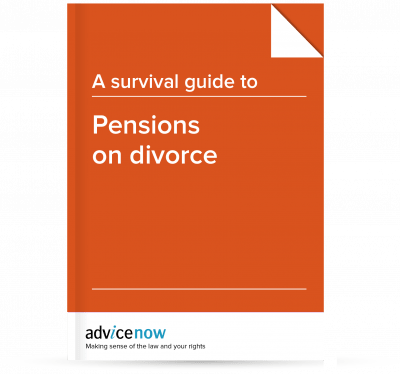What to do next depends on if you have managed to reach an agreement with your ex on how to settle finances, or not.
If you have an agreement, read this bit on what to do next. If you haven’t managed to reach an agreement skip to the bit called 'What to do if you can’t agree'.
What to do next if you have reached an agreement with your ex
If you have managed to reach an agreement with your ex about your finances the next step is to finalise it through the court. To do this your agreement needs to be turned into what is known as a ‘consent order’.
Consent orders
A consent order turns what you have agreed between you into a court order. Your agreement without a consent order is informal, not final, and usually not legally binding on you. This means it cannot be enforced by the court (although in some situations the court may be willing to turn a clear agreement into a consent order if one person was unreasonably trying to get out of it).
For your agreement to be made into a court order, it has to be written down in a particular format and sent to the judge to consider and approve. You usually don’t have to go to court yourself for the judge to do this.
When a consent order is made the court can make sure that what you have agreed actually happens. And, if the consent order is done properly (by a family lawyer), neither person should be able to ask the court to make a different financial order in the future.
Without a consent order, (or a final order made by the court at a final hearing), it is always possible for either you or your ex to apply to the court for something different to what you originally agreed, even long after you are divorced. This right is only lost when you remarry (although an exception to this rule is that the court can make pension sharing or attachment orders even when someone has re-married).
If you have agreed that you want to share a pension, then you will always have to get a consent order because the pension provider has to receive an order from the court before they can share the fund.
So, it is important to put any agreement you reach into a draft consent order for the court to approve if you want to:
- Make your agreement legally binding on both of you.
- Be able to enforce the order, if for example your ex does not do what they agreed to do such as pay you maintenance or a lump sum.
- Get an order that enables a pension to be shared between you.
- Bring to an end the right that you both potentially have to ask the court for a financial order at a later date.
Assuming the court approves your agreement, you will then have a legally binding order that you can both rely on. Depending on what it says in your consent order one or both of you will probably have a few more tasks to do – for example, you may need to get the family home on the market for sale or ask a pension provider to action a pension sharing order. Lawyers use the word ‘implementation’ to describe the stage when you take steps to put the consent order into action.
Next, we explain:
- how to prepare and apply for a consent order,
- when to apply for your final divorce order,
- how to make sure any pension sharing order actually happens or is ‘implemented’, and,
- the impact of a pension sharing order.
How to prepare and apply for a consent order
Step 1 - applying for your divorce
Before you can apply for a consent order to finalise your financial agreement one of you needs to apply to the court for a divorce. Or if you agree, you can make a joint application with your ex. There are various stages to getting a divorce. The court can only look at your application for a consent order when you have reached the conditional order stage of the divorce (or dissolution if you are ending your civil partnership). This takes some time so if you haven’t applied for a divorce yet, you need to start there. For more on this take a look at our guide How to get a divorce or end a civil partnership.
To get a consent order, you must apply to the court by sending in the draft consent order and other paperwork the court needs. Preparing even a simple draft consent order that will be accepted by a judge is not an easy task at all. You may well need some, or even a lot of, help from a lawyer.
It is also sensible to get legal advice on what you have actually agreed with your ex. It might be that there are things that you have not thought of, or are not aware of, that leaves one of you worse off. Without input from a lawyer on the fairness of the agreement there is a risk that a judge will look at the agreement and decide that it does not result in a fair outcome overall and will not approve it. If the judge refuses to make the order you have asked for, they will send it back to you and ask you to change it. Or, the judge may make the order without knowing that there were other important things missed out. This could cause you problems down the line. It’s better to be well informed before you spend time, money and energy applying to court. If you do need to start again you will probably need legal advice on how to reach an agreement the court will approve. This will take time and money.
You can find out more about getting expert legal advice on your agreement and help drafting a consent order in the section called Consent orders in our guide How to apply for a financial order without the help of a lawyer.
Step 2 - things to sort out if you are going to ask the court to make a pension sharing order
If your agreement with your ex does not include asking the court to make a pension sharing order you can skip this bit and go on to Step 3.
If your agreement with your ex includes asking the court to make a pension sharing order, there are forms you need to fill in and send to the court. There are important things you need to do before you can complete these forms.
Working out where the value of your pension sharing order will go
When the court makes a pension sharing order, that order gets sent to the pension fund manager and they have to make sure the pension share actually happens. This is known as ‘implementing’ the pension sharing order. Various things have to be arranged in advance for this to work. These are:
- Where is the money, known as the ‘pension credit’, from the pension going to go?
- How are the charges (if there are any) for the work carried out by the pension provider going to be paid?
If you are going to benefit from the pension sharing order where money, also known as ‘pension credit’, is taken from your ex’s pension, you need to work out where this is actually going to go.
One option is where the pension provider creates a pension for you within their scheme that is separate from your ex’s pension. This is known as an ‘internal transfer’. But, most pension providers, unless they are public sector pension schemes, will not do this - instead they say you need to transfer it to a pension scheme of your own. This is known as an ‘external transfer’. If you already have a pension scheme you may be able to get the money transferred to that pension scheme, if it is suitable. But if you don’t, you will need to set up a new pension scheme. It is a good idea to get independent financial advice on choosing a new pension scheme. This is because you are making a financial investment. When you do this the value of whatever you invest, in this situation a pension pot, can go up but it can also go down and essentially that means you can lose money. A lawyer cannot give you financial advice.
You might find that the pension provider offers you the choice of an ‘internal’ or ‘external’ transfer. And you will need to decide if you want your share of the pension to stay with your ex’s pension provider or if you want to move it to a different one. Deciding which will give you the best outcome financially is very difficult without advice from a financial adviser who specialises in pensions on divorce.
When you have worked out where your share of the pension is going to go you need to get it all set up so that you have the actual details of the new pension fund. You need to give these details to your ex’s pension scheme so that they can implement the pension sharing order and transfer the money to your chosen pension scheme. If it is an internal transfer, they keep the money in their scheme but in your name.
Many pension providers charge a fee for the work they have to do to make the pension share happen - this is known as ‘implementing’ the pension sharing order. You will see what charges the pension provider charges in their answers to your Form P and in their transfer value divorce pack. The fees vary a lot, from no fee at all to around £4,000.
You need to discuss how you will divide these charges between you and your ex. Usually these fees are divided equally between you. It is a good idea to find out from the pension provider how much the charges are in advance, so that you and / or your ex are ready with the money when you need to pay. The person receiving the pension share can often have their share of the fees deducted from their pension share before it is transferred to their new pension.
Sometimes paying this fee is the very last thing that has to be done in the divorce process. Some people can be difficult about paying the money, to hold up the process and to upset the person who will benefit from the pension sharing order. This can be a way of trying to control the other person right until the end of the marriage.
If you think your ex may behave in this way it is possible to ask that they give something called an ‘undertaking’ to the court. An undertaking is a formal promise to the court which can be enforced like a court order. A person who breaches an undertaking can be found to be in contempt of court and punished with a fine or a prison sentence or both. In this situation if you are worried your ex might hold things up, they could give an undertaking to do all that is necessary to ensure that the pension sharing order is implemented.
Step 3 - paperwork you need to agree on and complete
- Draft consent order - this document needs to be written up in the format that the court will accept. You will need the help of a lawyer to do this. When you and your ex have agreed the final version you both need to sign it.
- Statement of information for a consent order (D81 form) - this is a document that sets out both your financial circumstances. You need to fill this in very carefully using accurate figures from your paperwork about your income, property, savings and pensions etc. The figures that go in this form are the figures about your financial situation at the time you fill it in and then you are asked to put in figures about how your financial situation will be after the order is made. You just need to put in figures about your situation and then your ex will put in their figures. Or the other way round. When each of you has filled this in you need to sign to say you have seen the other person’s financial information. You also need to sign the statement of truth in the form, to confirm that the information you have provided is complete and true. Again, this form isn’t straightforward so it can be money well spent to have a specialist family lawyer help with this.
- Pension sharing annex (Form P1) or pension attachment annex (Form P2) - this is an extra form that tells the court about the details for making the pension order actually happen. This form then gets sent to the pension provider so that they have all the details they need to make the pension order to go ahead. This form isn’t straightforward either so it can be money well spent to have a specialist family lawyer help with this.
- It is sensible to send a copy of the consent order you want approved and the pension sharing annex to the pension provider before you send your application to the court in case they object for some reason or have other issues. It is not helpful to find this out after you have applied to court! In the unlikely event that you are applying for a pension attachment order you must send a copy of the consent order and the annex to the pension provider first. If there is enough time try and get a response before you apply to the court. Chase the pension provider until you get a reply.
- Form A - this is the form that tells the court you want to apply for a consent order. (There are lots of pages in this form about going to mediation but don’t worry if you haven’t - you do not need to when you are applying to the court for a consent order). To apply for a consent order one of you needs to take the lead and become the ‘applicant’ - even though you have reached an agreement you cannot apply together.
Step 4 - preparing your application for a consent order and sending it to the court
When you have heard back from the pension provider that they have no objections to your draft consent order you can take the next step of finalising all the paperwork and sending it to the court.
To ask the judge to look at and approve your draft consent order you need to prepare and send the following to the court:
- Draft consent order - signed by both of you, plus two copies.
- Statement of information for a consent order (D81 form)
- Form A - this is the form that tells the court you want to apply for a consent order.
- Pension sharing annex - Form P1 - if you are asking the court to make a pension sharing order or Form P2 if you are asking the court to make a pension attachment order.
- The court fee - £53, or the help with court fees form if you are on a low income.
If you can afford to get any help from a specialist family lawyer with these documents, it will be worthwhile. It is not a simple process and they can help guide you through it. You may find a lawyer who is happy to do bits of the work and suggest where you can save costs by doing the less complicated bits yourself. Even if you end up doing most of it yourself, it would be a really good idea to get it all checked over by a lawyer before you send it to court. That way you can be sure that the draft consent order sets out what you need it to, so that you don’t end up in a financial position that you were not expecting. Also, a lawyer can pick up on any errors so the application is less likely to be rejected by the judge - which will of course save you time and stress in the long run.
When all the documents are ready make a copy for your own records. Then you need to send all the paperwork and the fee (or help with court fees form) to the court. You can find the address details at the end of the Form A application.
Top tips!- Make copies of all the documents you send to the court.
- Make a note of the date when you send your documents to the court so that if you need to contact them you can be sure of when you sent it all in.
|
What happens next
The court will put your application on their system and then a judge will look at it - this could take around a few weeks but it could take a lot longer depending on how busy the court is.
If the judge has all the necessary information they need and agrees that the draft consent order will give you both a fair outcome they will approve it. Then the court will send copies of the order to you and your ex.
Top tips!- Take copies of the order - you will need to send a copy to other people, such as a pension or mortgage provider.
- Keep the order and the copies in a safe place.
|
If the judge refuses to approve the consent order you will probably need to get legal advice on how to change it in line with whatever comments the judge made when they rejected it. Take a look at the section called More help and advice on how to find a good lawyer.
If you have a Will you need to change it when your divorce is finalised - that is the date of the final divorce order. This is because, when it comes to your Will, it is as though your ex died on that date. Anything you have left to your ex in your Will won’t go to them. Instead of your estate passing to your ex it could pass in line with the intestacy rules. This means your estate may not go to a new partner (unless you have entered into a new marriage or civil partnership).
If you don’t have a Will it is really important to make one so that when you die what you own goes to the person or people you want it to, who may not be the same people as under the intestacy rules.
If talking about making a Will has made you wonder what will happen to your pension(s) when you die, start by going to MoneyHelper.
When to apply for the final divorce order
The next step is to apply for final divorce order, or final order if you are ending your civil partnership. You can find out more about this in How to get a divorce or end a civil partnership without the help of a lawyer.
After the ups and downs you have been through, and after all the time it has taken you to get here, you will probably be keen to apply for the final divorce order as soon as you can. But there is a very good reason to hold off for 28 days after the date that the court approves the consent order. We explain why next.
The pension sharing order only becomes legally binding or as the law calls it - ‘it takes effect’ - after the final divorce order is made, whenever that is.
The pension sharing order takes effect on whichever is the later of these two dates:
- the date the final divorce order is made, or
- 7 days after the time given to appeal the consent order, runs out. Usually the time in which to appeal is 21 days, so in total this is 28 days from the date of the consent order.
If you apply for the final divorce order straight away after the consent order is made, your divorce will probably be finalised before the pension sharing order takes effect. This would mean you would no longer be married. If the person with the pension dies unexpectedly in this time, before the 28 days have passed, you are unlikely to be legally entitled to receive potentially very valuable death benefits under the pension as the pension holder’s husband, wife or civil partner. But also, the rights you are entitled to under the pension sharing order will not now take effect. This means you lose out completely on the pensions in the case.
So, to avoid this unlikely but potentially catastrophic situation, it is usually best to wait 28 days from the date the judge approved the order, before applying for your final divorce order. Then the pension sharing order takes effect as soon as the final divorce order is made. It can be a good idea to include a section in the consent order that records that you both undertake not to apply for the final divorce order until 28 days after the date the order is made. If just one of you applied for the divorce in the first place (rather than you applying together) it is a good idea for that person to give an undertaking that they will do everything needed to apply for final divorce order as quickly as possible after the 28 days have passed. For a reminder on what an undertaking is, take a look at the section called What does it mean?
Making sure the pension sharing order is implemented
When you have the approved consent order and the final divorce order you can ask the pension provider to get on with the task of making the pension share happen, known as ‘implementing’ the pension sharing order. The pension provider will not start on the task until they have been sent everything they need.
They will definitely need the following (but may ask for other things too):
- a copy of the consent order,
- a copy of the pension sharing annex,
- a copy of the final divorce order,
- payment of their charges (if there are any or a signed letter to confirm they can deduct your share of the charges from the transfer value before it is sent to your chosen pension scheme, if this is an option),
- the details of the new pension scheme that is going to receive the share of the pension.
It is a good idea to get all this paperwork to the pension provider as soon as you can, as they then have four months from the date of receiving all of documents they require to implement the order.
If you are the person who is going to benefit from the pension share it is usual for you to send all the paperwork to the pension provider and make sure they have received payment from whoever is due to pay their fees. It is a good idea to send the documents as soon as possible after you receive them. So, for example, send the pension provider the copy of the consent order as soon as you can and then send the final divorce order later. This lets the pension provider know that an order has been made and that you are now due to benefit from the pension as well, not just your ex.
The impact of the pension sharing order
Situation 1 - If you are the person receiving the benefit of the pension sharing order
Unfortunately, it is not immediately clear how much you will receive, either as capital in a new pension pot or as income if you have already retired. During the negotiations, or court case if you don’t manage to agree things, you will have had the Cash Equivalent values of whatever pensions there are between you.
When it comes to the end of the process, when the pension provider finishes all the work involved to get one pension made into two, they will calculate a new value that is different to the one used in negotiations. This is because they can only share out what actually exists in the pension pot when the divorce is finalised and the pension sharing order takes effect. Sometimes, because pensions are investments and subject to changes in the financial markets, the value used when you were negotiating an agreement might have gone down by the time the pension sharing order takes effect. If it does go down, there will be less to share between you. Although, if it has gone up there will be more to share out.
Situation 2 - If you are the person whose pension pot is being shared
If you are older and already receiving your pension at the time a pension sharing order is made this will have an impact on your monthly income. You need to be aware that from the time that the order takes effect (the date of the final divorce order or 28 days after final financial order, whichever is later) you are only entitled to a certain share of your original pension, which will eventually be reduced by the percentage in the final financial order. In this time, you will receive your usual amount each month, but your ex is legally entitled to some of it because of the pension sharing order. When the order is finally implemented by the pension provider you will see a reduction in your payments, but it will normally take months (and sometimes even years) before this happens. So, you need to be prepared for the pension provider to ask you to repay the overpaid monthly payments back to the date the order came into effect. Lawyers call this ‘clawback’.
If you think you might be in this situation it would be very helpful to get advice on whether it is going to be a significant amount of your monthly income for that period so that you can be ready, as far as possible. Not only will your monthly payments reduce when the order is finally implemented, but there could be a further reduction for a year or two while the pension provider recovers the overpayments.
Implementing the pension sharing order is quite a complicated process and sometimes pension providers actually make mistakes when transferring the pension share to a new pension scheme. So, if you can find the money to get advice from a financial adviser familiar with this process to help you through it and to check that the order has been properly put into action, it is likely to be money well spent.
What to do if you can’t agree
If neither of these approaches work, for example because your ex is being generally uncooperative or extremely slow, then your only option will be to apply to court if you want to finalise your divorce and sort out finances. Your ex may be in touch with you but you might be worried they are not telling you everything about their finances. This can happen even when you have a lawyer to help. You may find you need the court’s help to make your ex provide all their financial information. If you are worried that your ex is spending too much money on purpose to stop you from getting a fair share or hiding assets in some way, you need to urgently get advice from a lawyer on how you may be able to stop this. See the section called More help and advice.
It can feel daunting to start talking about court with your ex if you don’t communicate easily or, even, at all. There are two sample letters at the end of this guide that you might want to adapt and send or email to your ex to bring up the issues in a calm but firm way.
If you think you may need to apply to court start by taking a look at our guide called How to apply for a financial order. The guide takes you through the whole process step by step.








 The next question is whether or not you need expert help to work out if the cash equivalent valuations give a proper picture of the value of the pensions in your case. You will need to weigh up the costs of doing this with the benefits you will get from expert advice. This section looks at when it is likely to be very tricky to work things out by yourself and so will be worth getting expert help. Then in
The next question is whether or not you need expert help to work out if the cash equivalent valuations give a proper picture of the value of the pensions in your case. You will need to weigh up the costs of doing this with the benefits you will get from expert advice. This section looks at when it is likely to be very tricky to work things out by yourself and so will be worth getting expert help. Then in 








